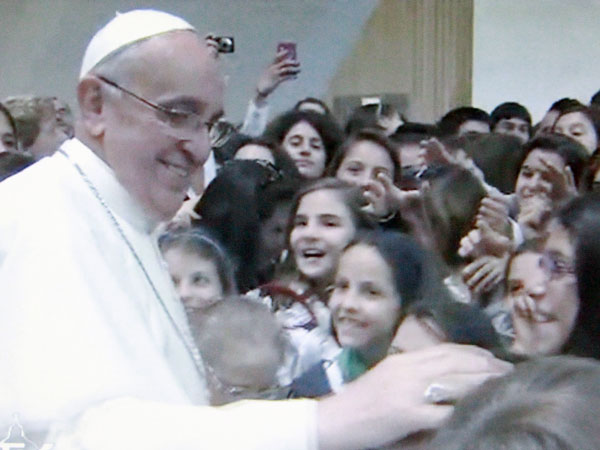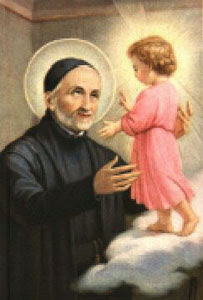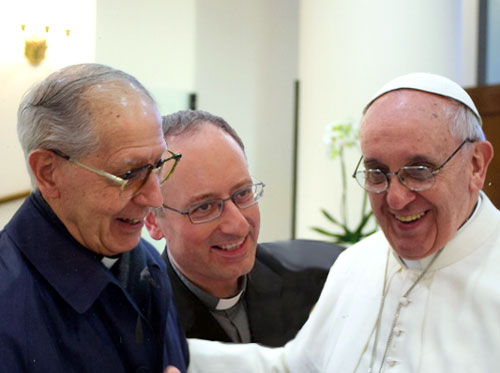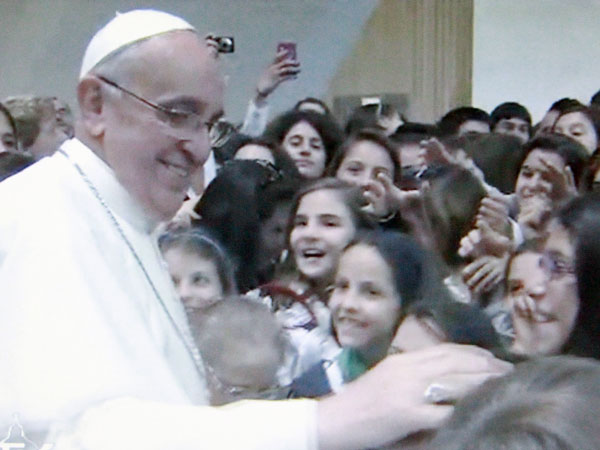“happy”

You feel happy when you see the one you love dearly is happy.
“heaven”

“Those who carry God in their hearts bear heaven wherever they go.”
──ST.Ignatius of Loyola
Wisdom Story 63

by Paul Brian Campbell,SJ
Everything said about God is false.”
The disciples knew what was coming next.
The master continued, “Words are only a distortion of a reality that can never be comprehended by reason.”
Frustrated, the disciples asked him what they should do.
“Just be in silence.”
A young disciple ventured, “Why do you keep on talking then?”
The master smiled. “Ah, but you have not understood. Don’t just listen to my words. Listen to the silence.”
Gettysburg’s Catholic Memories

M. Kenney, S.J.
From July 5, 1913
The celebration this week of the fiftieth anniversary of the great battle that set forever “the high water mark of the Confederacy” and opened the way to the reestablishment of the Union in all our territory, makes it appropriate to recall some incidents of the memorable conflict that have a special interest for Catholic Americans. There was scarcely a battle in the four years’ war that has not its Catholic memories, but the field of Gettysburg is, we believe, the only one in which one of the most striking of its many monuments represents a Catholic priest in military uniform, stretching out his hand to absolve and bless.
On July 2, 1863, the second day of the battle, occurred the famous incident which the Corby monument commemorates. As the men of the Irish Brigade advanced to check the onrush of Anderson’s Confederates on the ensanguined and now celebrated Wheat Field, their chaplain. Rev. William Corby, C.S.C., took a conspicuous position on a boulder, and having in a short address informed them that he was about to impart a general absolution, and that they could receive its benefit by making a sincere act of contrition, with a resolve to confess their sins on the first opportunity, ended, says General Mulholland, with the declaration that “the Catholic Church refuses Christian burial to a soldier who turns his back on the foe or deserts his flag. The brigade was standing at ‘order arms,’ and as he closed his address every man fell on his knees with head bowed down. Then stretching his right hand towards the brigade, Father Corby pronounced the words of absolution.”
“In performing this ceremony,” writes Father Corby in his ‘Memoirs of Chaplain Life,’ “I faced the army. My eye covered thousands of officers and men. I noticed that all, Catholics and non-Catholics, officers and private soldiers, showed a profound respect, wishing at this fatal crisis to receive every benefit of Divine Grace that could be imparted through the Church’s ministry. Even Major-General Hancock removed his hat, and as far as compatible with the situation, bowed in reverential devotion. That general absolution was intended for all- in quantum possum-not only for our brigade, but for all, North and South, who were susceptible of it and who were about td appear before their Judge…
“The Irish Brigade had very many advantages over other organizations, as it was at no time during the war without a chaplain; but I was the only one at the battle of Gettysburg. Often in camp, and sometimes on the march, we held very impressive religious services, but the one at Gettysburg was more public, and was witnessed by many who had not, perhaps, seen the others. The surroundings there, too, made a vast difference, for really the situation reminded one of the day ofjudgment, when shall be seen ‘men withering away for fear and expectation of what shall come upon the whole world,’ so great were the whirlwinds of war then in motion.”
General Mulholland, who as a Major in the brigade, received the absolution, states in his “History of the 116th Pennsylvania Volunteers,” that “this was, perhaps, the first time it had ever been witnessed on this Continent.” In fact, however, general absolution had been similarly given by several chaplains during the war. Father Tissot, S.J., mentions in his Memoirs, that before each battle he absolved the regiments as they marched past, having previously instructed them to be ready.
At the battle of Mine Run, of the same year, Father Michael Egan, O.P., of the Ninth Massachusetts, had his men drawn up in a hollow square about him by Col. Patrick Guiney, and gave them absolution just before, at Warren’s word, they charged the enemy; and as early as 1779, Father Gibault gave general absolution to General Clark’s little army of French Creoles, as they set out from Kaskaskia, under Captains McCarthy and Charleville, to recapture Vincennes, and win the Northwest. “We were conducted out of town,” says Clark, “by Mr. Gibault, the priest, who after a very suitable discourse, gave us all absolution.”
But it was at Gettysburg that the act was first fittingly commemorated, and for this General Mulholland was mainly responsible. At his suggestion the Catholic Alumni Sodality of St. Joseph’s College, Philadelphia, undertook the work, and on October 29, 1910, unveiled a bronze statue of Father Corby, with absolving hand outstretched, on the spot where he had stood when imparting absolution. It is one of the most beautiful, as well as notable, of the many memorials that mark the great events of that fateful field. The heroic figure of the chaplain is represented in the uniform of a captain of cavalry, and wearing the priestly stole.
Another is that of the Irish Brigade itself. On July 2, 1888, twenty-fifth anniversary of the second day of Gettysburg, a memorial service was held on the field by the few survivors of that many battled Brigade, and a monument unveiled to its dead. It is in the form of an ancient Celtic Cross, with the Irish wolf dog sleeping at its base. The ceremony began with a military Mass, sung by Rev. Thomas Ouellet, S.J., who was chaplain of the 69th Regiment of the Brigade in 1861 and 1862. Father Corby was also present and made a touching address to the scant and feeble remnants of his old Brigade. There are other regimental monuments on which a cross or shamrock’ might well bear witness to the prevailing creed and race of the ranks whose heroism they commemorate.
The Irish Brigade were but a fraction of the Catholics who fought at Gettysburg. Sadly reduced in the many battles of the long campaigns on the Potomac, again reinforced by the efforts and prestige of GeneralMeagher, it had been practically annihilated in its heroic charges, many times repeated, against the impregnable rocks of Fredericksburg. Its conduct there was of a piece with that of Pickett’s men at Gettysburg, except that the task assigned it was still more glaringly impossible. General Meagher, who two months previously had resigned his command when refused permission to recruit it to its strength, was serving elsewhere, and little over 500 men fought under its colors at Gettysburg; but these, commanded by Col. Patrick Kelly, who fell at Petersburg, maintained its high traditions. As they rose from their knees, “the command ‘Forward!’ immediately followed the sacred words of the priest,” wroteComte de Paris in his “History of the Civil War” (Vol. Ill, p. 620), “and the Irish have at once rushed into the thickest of the fight. They suddenly stop Anderson’s brigade in its advance.” It was a critical moment for Round Top, and its saving was the loss of many. As General Mulholland finely said, “they had knelt in their grave clothes.”
Among Catholic officers who were prominent in the three days’ fight was Major-General Newton, the famous engineer, who commanded the First Army Corps, and first bore the brunt of Pickett’s terrific assault Brigadier-General Joseph B. Carr commanded the First Brigade, Second Division; Col. James Mallon, 42nd New York; Col. R. Byrnes, 28th Massachusetts; Col Patrick Guiney, 9th Massachusetts; Col. Patrick Kelly, the Irish Brigade; Major (later General) Mulholland, 116th Pennsylvania; Major Michael Burns, 73rd New York; Col. Thomas Smyth, 1st Delaware ; Col. Patrick O’Rorke, 140th New York.
Col. Smyth afterwards commanded the Irish Brigade, and was the last Union general officer who was killed in the war, having been shot in a skirmish two days before the surrender at Appomattox. Col. Patrick O’Rorke saved Little Round Top from being captured by the Confederates in a decisive moment of the desperate fight, and thereby sacrificed his life. He was a young Irishman who, after a brilliant course at West Point in the class of 1861, went immediately to the seat of war, and was soon recognized as one of the most promising officers in the army. While leading his men in defense of Little Round Top, when it was being fiercely assailed by Pickett’s foremost line, he caught up the colors in the very crisis of the battle and mounted a rock to urge on his men. He was struck and fell dead, but his company held the position. Comte de Paris, who speaks of this as the most striking and dramatic episode of the battle, paid tribute to his heroism. Col. O’Rorke’s young widow became a Religious of the Sacred Heart in New York, and proved one of the most efficient of that accomplished company of educators.
General Judson Kilpatrick, 3rd Division, and General James Longstreet, the Confederate Commander who advised against Pickett’s charge, became Catholics after the war. General Meade, the victor of Gettysburg, had been baptized a Catholic, but his parents having soon after drifted from religious practice in the lamentable Philadelphia Church quarrels of the period, he was not brought up in the Catholic Faith. He belonged to a family of Irish Catholic pioneers in Philadelphia, whose original name was O’Meagh. His grandfather, George Meade, was an ardent patriot of the Revolution, the brother-in-law and partner in business of Thomas Fitzsimmons, one of the two Catholic Delegates who helped to frame the American Constitution. The late Martin I. J. Griffin thus refers to him’ in the American Catholic Historical Researches of October, 1895:
“The visitor to St. Mary’s graveyard in this city as he steps inside this ancient burial place sees the elevated vault, where underneath all that may remain of Commodore John Barry and his two convert wives repose. Right next to it, similar in size and shape, is the Meade tomb and grave. In it are the remains of the grandfather of the late Gen. George Gordon Meade, the hero of Gettysburg, who was born in Spain, December 30,1815, and baptized in the Catholic Church, January 8, 1816. His godmother was Christiana Gordon y Prendergast, mother of the Marquis of Las Tunas…That he was not one of ours was due to the faith- destroying Hogan-Harold-Conwell schism of seventy years ago.”
During the battle, and for weeks after, the Catholic Church of St. Francis Xavier, Gettysburg, became a hospital for the wounded, who were carefully tended by the then pastor, Father McGinnis, and by the Sisters of Charity, who hurried to their aid from St. Joseph’s Emmitsburg, ten miles across the mountains. It will doubtless be visited by thousands during the celebration, and none can give them better information of the battle and its monuments than its zealous and hospitable pastor. Rev. W. F. Boyle. St. Francis Xavier has an historic interest of its own. Founded in 1830 for the scattered but loyal and fervent German Catholics of the district by Rev. Matthew Lakieu, S.J., Superior of the Jesuits at Conewago, its first pastor was Rev. Michael Dougherty, S.J., and his successors include the distinguished Jesuit names of Paul Kohlmann, Joseph Dietz, George Villiger, James B. Cotting, and F. X. Deneckere. A new church was erected in 1852, and dedicated by the saintly Bishop Neumann. The church was transferred to the secular clergy in 1858, and in 1864 Rev. J. A. Boll repaired, the damages it suffered during the battle. It was destroyed by fire in 1893, but at once rebuilt, and the present hand some edifice was dedicated, 1896. Attached is an excellent school and academy, founded by Father Boll in1877, and conducted since 1899 by the Sisters of Charity of Emmitsburg.
Passing from the Catholic Church to the gateway of that part of the Gettysburg field which is now a national cemetery, the visitor is at once confronted by an eloquent Catholic reminder. Over the entrance are inscribed the lines from the immortal poem of the valiant and brilliant
Catholic soldier. Col. Theodore O’Hara, which form the epitaph for America’s warrior dead:
“On Fame’s eternal camping ground
Their silent tents are spread.
And Glory guards with solemn round
The bivouac of the dead.”
Bishop Thomas Dowd

The Canadian Church is becoming increasingly engaged in new media. Arguably, the person who started the trend was Bishop Thomas Dowd, the first Canadian priest with a blog (titled “Waiting in Joyful Hope”). Now an Auxiliary Bishop in Montreal, Bishop Dowd has extended his online ministry to Facebook and Twitter. In this Witness interview filmed at the 2011 CCCB Plenary Assembly in Cornwall, Ontario, the newly ordained bishop offers his insights on the Church in the digital age.
Best Ignatian Songs: Beautiful Dawn

by Jim Manney
Break-up songs are so plentiful that they constitute a whole category of popular music. My personal favorite is Dylan’s “Don’t Think Twice, It’s Alright.” “Beautiful Dawn” by the Wailin’ Jennys is right up there too. It’s sad, lovely, and gracious. The way to mend a broken heart is to pray like this.
Teach me how to see when I close my eyes
Teach me to forgive and to apologize
Show me how to love in the darkest dark
There’s only one way to mend a broken heart
【List of historical anniversaries】

1648/ The martyrdom in Canada of St. Anthony Daniel, who was shot with arrows and cast into flames by the Iroquois.
1751/ General Congregation XVII elected 69-year-old Ignacio Visconti to be superior general. An affable man known as the “angel of peace,” he governed four years.
Pope’s general audience of June 26

07 June, 2013. There were about nine thousand people including, students, educationists, Parents, Ignatian youths and Jesuits from Italy and Albania in the Paul VI hall in the Vatican for the special audience with Pope Francis. His message to the future generation stressed on the point of taking up the special task of uplifting humanity from the present situation of economic and power struggle to social relationships. He answered many personal and general questions from the students representatives.
More information and video clips will be available on the site:
http://www.radiovaticana.va/
St. Bernadine Realino

Today’s saint of the day is St. Bernadine Realino, who is also known as the Apostle of Leece.
Bernadine was born in 1530 in Capri, Italy, a city located in the northern part of Italy, to noble parents. He studied law and medicine in Bologna and initially became an attorney, followed by a political career, in which he served as judge, tax collector, Superintendant of the fiefs of the marquis of Naples, and mayor of three different cities in Italy.
While in Naples, Bernardino, now 34 years old, met some priests of the Society of Jesus and made an eight-day retreat with them. During this retreat, he felt a strong call to the religious life and asked the Jesuits for admittance into their Society. He was accepted and ordained a priest in 1567. For ten years he served in Naples, preaching, teaching catechism, visiting the sick, the poor, and those in prison. He also served as the novice master there. Then he was transferred to Lecce, a small city in southern Italy, where he was sent to found a college. He remained in Leece for the last forty-two years of his life.
Bernadino was well-known and loved for his work in Leece. He was a model confessor, a powerful preacher, a diligent catechist to the youth, as well as a Rector of the Jesuit college and Superior of the Community there. His charity to the poor and the sick knew no bounds and his kindness brought about the end of vendettas and public scandals. One of the miracles attributed to him involved his small pitcher of wine, which was never empty until everyone present had had enough.
He was loved so much and venerated that, as he lay on his death bed in 1616, the city’s leaders requested that he take the city under his protection. Unable to speak, St. Bernardino bowed his head. He died with the names of Jesus and Mary on his lips.
St. Bernadino was canonized in 1947 by Pope Pius XII. He is the patron saint of Leece, Italy.
What helped to make St. Bernadino even more famous are the events that followed his death. Six years prior to his death, he fell and sustained two wounds that refused to heal. While he was in his last illness, those closest to him, who had witnessed his holiness, collected the blood discharged from these wounds in several small vials.
This blood acted strangely. In some of the vials, it retained its liquid consistency for over a century. In others it foamed or frothed, particularly on the anniversary of the saint’s death. Several witnesses testified to these phenomena during the investigation before his beatification. When his tomb was opened in 1711, some of his fleshy tissue remained incorrupt, floating in a dark red liquid. This too, proved to be human blood, and it gave off a sweet perfume. In 1713 it was also found to be frothing or bubbling, as it was again in 1804 and 1852. In 1985, however, none of the blood preserved showed any of these tendencies.
Be Men of the Frontier

4 June, 2013. Dialogue, discernment and frontier, were the three words focused by Pope Francis this morning, during a private audience with the community of the “Catholic Civilization”(Civiltà Cattolica), the magazine of the Jesuits founded in 1850. The Pope asked in particular to the writers of the fortnightly, directed by Father Antonio Spadaro SJ, to be “men of the frontier”, committed to build bridges not walls. Therefore, urged them to engage in dialogue with those who do not share the Christian faith. The homage was addressed to the Pope by Rev. Fr. Adolfo Nicolás SJ, the Superior General of the Society of Jesus. Courtesy: Vatican Radio



